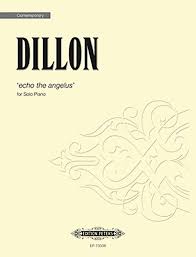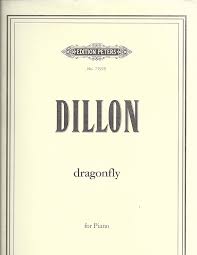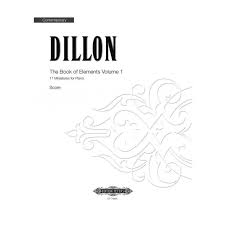Table of Contents
James Dillon – echo the angelus (sheet music)
Come join us now, and enjoy playing your beloved music and browse through great scores of every level and styles!
Can’t find the songbook you’re looking for? Please, email us at: sheetmusiclibrarypdf@gmail.com We’d like to help you!

Best Sheet Music download from our Library.
Performed by Noriko Kawai, piano
113 Twin Cities New Music Festival 2023
Please, subscribe to our Library.
If you are already a subscriber, please, check our NEW SCORES’ page every month for new sheet music. THANK YOU!

Who is James Dillon?
James Dillon (born 1950) is a British composer known for his complex, avant-garde music that pushes the boundaries of contemporary classical composition. His works often feature intricate structures, extended techniques, and a deep engagement with both modernist and postmodernist aesthetics.

Early Life and Education
Born in Glasgow, Scotland, Dillon initially studied painting and architecture before turning to music. He is largely self-taught as a composer, though he later studied at the Royal College of Music in London. His early influences included modernist composers like Karlheinz Stockhausen, Pierre Boulez, and Iannis Xenakis, as well as jazz and non-Western musical traditions.
Musical Style and Works
Dillon’s music is characterized by its extreme complexity, dense textures, and rigorous structural approach. Some key features of his style include:
- Microtonality and complex tuning systems – He often explores alternative tuning systems beyond traditional equal temperament.
- Polymetric and polyrhythmic structures – His works frequently involve layered, conflicting rhythms.
- Extended instrumental techniques – He demands highly virtuosic performances, often requiring unconventional playing methods.
- Influences from literature, philosophy, and visual arts – Many of his pieces reference poetry, mythology, and abstract concepts.
Notable works include:
- Nine Rivers (1982–99) – A massive cycle of compositions exploring fluidity and transformation.
- L’Œuvre au Noir (1990) – Inspired by Marguerite Yourcenar’s novel, this orchestral work is a meditation on alchemy and transformation.
- The Book of Elements (1996–2005) – A series of solo piano pieces showcasing his intricate approach to form and gesture.
- Philomela (2004) – A chamber opera based on the Greek myth of Philomela, blending avant-garde vocal techniques with dramatic storytelling.

Reception and Influence
Dillon’s music is highly respected in contemporary classical circles, though its extreme difficulty means it is performed less frequently than more accessible works. He has been associated with the New Complexity movement, alongside composers like Brian Ferneyhough and Michael Finnissy, though he resists strict categorization.
Teaching and Legacy
Dillon has taught at institutions such as the University of Minnesota and the Royal Academy of Music in London. His influence extends through his students and the performers dedicated to interpreting his demanding works.
Awards and Recognition
- Royal Philharmonic Society Award (1984, 1997)
- Ernst von Siemens Music Prize (2015) – One of the highest honors in contemporary classical music.
James Dillon remains one of the most intellectually rigorous and challenging composers of his generation. His music demands deep engagement from both performers and listeners, offering a rich, if often difficult, sonic experience. For those interested in avant-garde composition, his work is essential listening.
Exploring The Book of Elements by James Dillon
The Book of Elements (1996–2005) is a monumental cycle of five volumes for solo piano, showcasing Dillon’s intricate, highly structured, and virtuosic approach to composition. Each volume consists of multiple short movements (or “elements”), exploring different facets of musical language, from explosive gestures to delicate, pointillistic textures.
Key Features of The Book of Elements
- Structural Complexity: The pieces are built from dense, layered rhythms, microtonal inflections, and extreme dynamic contrasts.
- Notational Innovation: Dillon’s scores are famously detailed, requiring the pianist to navigate intricate polyrhythms and unconventional techniques.
- Abstract Narrative: Though not programmatic, the work has an almost literary quality—each “element” feels like a fragment of a larger, enigmatic discourse.
- Influences: The music draws from spectralism, serialism, and even jazz improvisation, filtered through Dillon’s unique aesthetic.
Recommended Recordings
- Ian Pace – The Complete Book of Elements (Metier, 2018)
- The definitive recording, as Pace is one of the foremost interpreters of Dillon’s piano music. His technical mastery and deep understanding of the work’s architecture make this essential.
- Includes all five volumes, offering a comprehensive view of the cycle.
- Nicolas Hodges – Volume 1 & Selections (Various recitals)
- Hodges, another leading new music pianist, has performed excerpts in concert. While no complete commercial recording exists, live performances (some on YouTube) demonstrate his dynamic approach.
Where to Start Listening
If you’re new to Dillon’s piano works, try these entry points:
- Vol. I, Element 1 – A striking introduction, full of sharp attacks and sudden silences.
- Vol. III, Element 6 – A slower, more atmospheric piece, revealing Dillon’s lyrical side.
- Vol. V, Element 9 – One of the most virtuosic sections, with cascading clusters and rapid shifts in texture.
Further Exploration
- Compare with Brian Ferneyhough’s Lemma-Icon-Epigram or Michael Finnissy’s The History of Photography in Sound for similar complexity.
- If you enjoy The Book of Elements, explore Dillon’s Nine Rivers* cycle** or his **violin concerto *Via Sacra for larger-scale works.
Browse in the Library:
Or browse in the categories menus & download the Library Catalog PDF:
